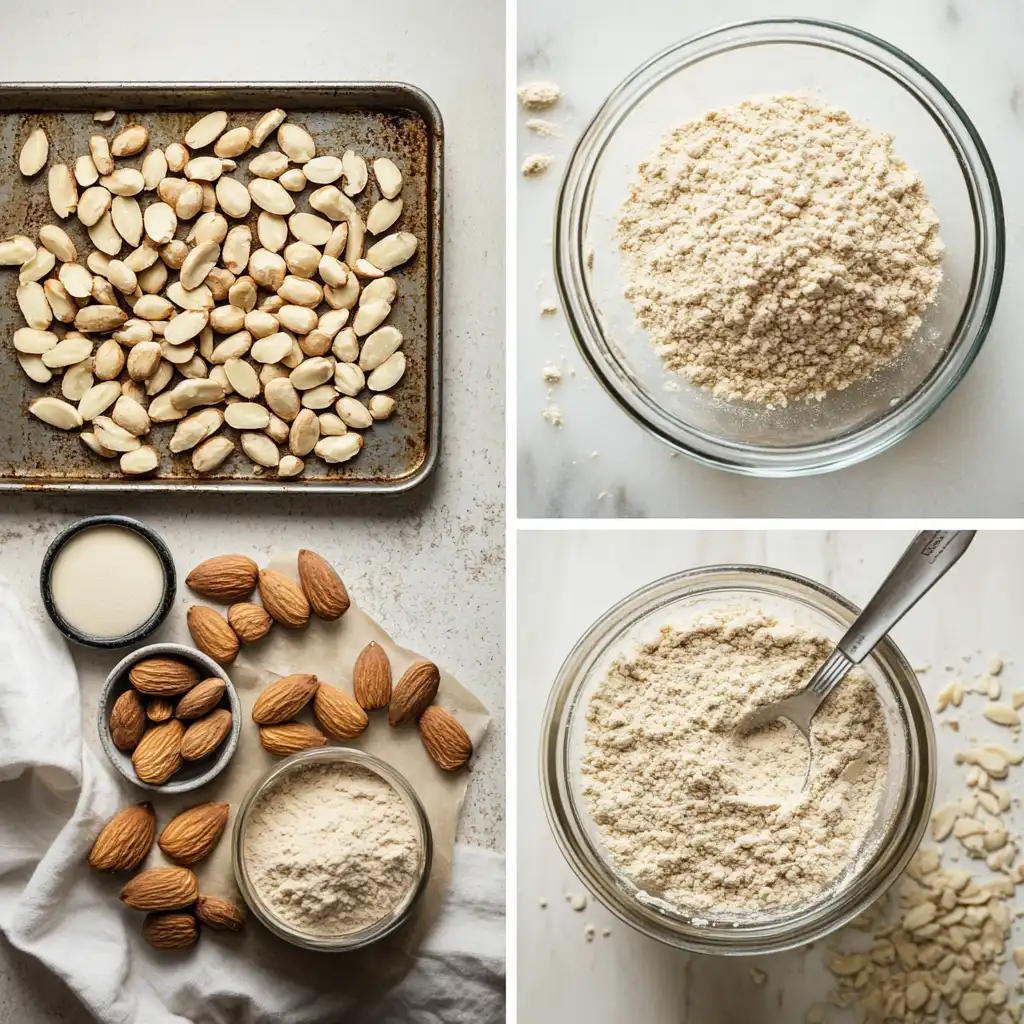
Flour is the foundation of most baked goods, providing structure, texture, and flavor. However, with dietary needs evolving, substitutions have become increasingly common. One popular alternative is almond flour, which offers a gluten-free option with unique nutritional benefits. But can you substitute almond flour for all-purpose flour in muffin recipes? Understanding how to substitute almond flour for all-purpose flour correctly is essential for maintaining texture, flavor, and moisture.
Table of Contents
What is Almond Flour and How Does it Compare to Traditional Flour?
How is Almond Flour Made? A Guide for Gluten-Free Baking
Almond flour is made by finely grinding blanched almonds. The process involves several careful steps to ensure a fine, consistent texture.
- Blanching: Almonds are boiled briefly, and their skins are removed to create a lighter flour.
- Drying: After blanching, the almonds are dried thoroughly. This step is essential to achieve an even grind and prevent clumping.
- Grinding: The dried almonds are ground to a fine texture, similar to traditional flour.
- Sifting: Finally, the flour is sifted to remove any remaining coarse particles.
This process results in a smooth, pale flour that works well in gluten-free and low-carb recipes. When you substitute almond flour for all-purpose flour, this fine texture helps achieve better results in baking. Additionally, almond flour has a mild, nutty flavor that complements both sweet and savory baked goods. If you’re looking for ideas, try these cinnamon sugar muffins, which can be adapted with almond flour.
Almond Flour vs Almond Meal: Which One to Use in Gluten-Free Recipes?
It’s important to note the distinction between almond flour and almond meal. Almond flour is made from blanched almonds and has a fine, powdery texture. In contrast, almond meal is made from almonds with their skins intact, resulting in a coarser texture and darker color. Because of these differences, almond meal may not be ideal for recipes requiring a delicate crumb. However, almond meal works well for rustic recipes like breading or hearty muffins. Knowing which type to use can greatly affect your baking results.
Health Benefits of Almond Flour Compared to All-Purpose Flour
High in Protein
Almond flour provides about 6 grams of protein per ¼ cup serving, which is significantly higher than the 4 grams found in all-purpose flour. Consequently, this protein content helps support satiety, keeping you full for longer periods. Moreover, protein is essential for muscle repair and growth, especially if you lead an active lifestyle. The steady energy provided by protein also helps stabilize blood sugar levels, preventing energy crashes. For those looking to incorporate more protein-rich snacks into their diet, almond flour-based recipes like these matcha muffins are a great option.
Rich in Healthy Fats
In addition, almond flour is an excellent source of healthy fats. It contains approximately 14 grams of monounsaturated fats per ¼ cup serving. These fats are known to support heart health by lowering bad cholesterol (LDL) and raising good cholesterol (HDL). Furthermore, monounsaturated fats have anti-inflammatory properties that can help reduce joint pain and promote overall wellness. Unlike all-purpose flour, which contains minimal fat, almond flour’s healthy fats contribute to a richer taste and moist texture in baked goods. If you’re looking for nutrient-dense snacks, check out these rice cakes benefits and recipes.
Low in Carbohydrates
For those following low-carb, paleo, or keto diets, almond flour is a valuable ingredient. A ¼ cup serving of almond flour contains just 6 grams of carbohydrates, compared to 24 grams in the same serving of all-purpose flour. This significant reduction in carbs helps control blood sugar levels, making almond flour suitable for diabetics or anyone managing carb intake. Furthermore, reducing carbs can aid in weight loss and maintenance by minimizing insulin spikes. If you’re looking for a low-carb baking idea, these cinnamon sugar muffins can be adapted using almond flour for a healthier option.
What is All-Purpose Flour and How is it Different from Almond Flour?
How All-Purpose Flour is Made
All-purpose flour is refined by removing the bran and germ, leaving only the starchy endosperm. Specifically, the process begins with cleaning and milling wheat grains. The grains are then ground and sifted to separate the bran (outer layer) and germ (nutrient-rich core). This leaves behind the endosperm, which is ground into a fine powder. The resulting flour is either bleached or unbleached to achieve the desired texture and color. Because of its versatility, all-purpose flour is a staple in many kitchens, suitable for a wide range of baked goods. For instance, recipes like these cinnamon sugar muffins showcase the classic qualities of all-purpose flour beautifully.
Nutritional Overview
In comparison, all-purpose flour has a lower nutritional profile than almond flour. A ¼ cup serving contains about 4 grams of protein, 24 grams of carbs, and 1 gram of fiber. While it lacks the healthy fats found in almond flour, it provides energy through its carbohydrate content. Additionally, many commercial all-purpose flours are enriched with vitamins and minerals like folate, iron, and B vitamins to replace nutrients lost during processing. Consequently, this enrichment ensures all-purpose flour remains a reliable source of essential nutrients. For a versatile baking option, try these cinnamon sugar muffins that work well with all-purpose flour.
Almond Flour vs All-Purpose Flour: Key Differences for Baking Success

Gluten Content
One of the most significant differences between almond flour and all-purpose flour is gluten content. To clarify:
- Almond Flour: Naturally gluten-free. As a result, it requires binders like eggs or xanthan gum to provide structure.
- All-Purpose Flour: Contains gluten, which helps create elasticity and structure in baked goods.
When you substitute almond flour for all-purpose flour, baked goods may turn out denser and more crumbly due to the lack of gluten. For a better understanding, you can try experimenting with gluten-free recipes like these matcha muffins, which are designed to work without gluten.
Moisture Absorption
Furthermore, almond flour absorbs less moisture compared to all-purpose flour. This can lead to wetter batters, which may require adjustments to your recipe. Specifically, you might need to reduce the liquid content or extend the baking time. On the other hand, all-purpose flour absorbs moisture more consistently, which helps achieve a uniform texture. Understanding these differences can help you make informed decisions when substituting flour types.
How to Substitute Almond Flour for All-Purpose Flour in Muffin Recipes
Recommended Ratio
To begin with, when you substitute almond flour for all-purpose flour, you can typically start with a 1:1 ratio, though adjustments may be necessary. However, almond flour behaves differently due to its lack of gluten and higher fat content. Therefore, while a 1:1 substitution can work, you should expect a denser texture and moister crumb. To improve results, you can mix almond flour with other gluten-free flours, like coconut flour, to balance texture and structure. For instance, blending almond flour with coconut flour in recipes like these matcha muffins can yield a lighter, fluffier result. Additionally, experimenting with different ratios will help you find the perfect balance for your specific recipe.
Adjusting Liquid Ingredients
Since almond flour absorbs less moisture than all-purpose flour, it’s essential to adjust the liquid content in your recipe. When substituting almond flour, consider reducing the amount of liquid by about 25% or increasing the baking time slightly. Otherwise, the batter may turn out too wet, resulting in muffins that don’t set properly. You can also add extra eggs, which not only help bind the batter but also provide structure. Moreover, using binders like xanthan gum or psyllium husk can improve the texture and stability of your muffins. If you’re new to these adjustments, try following a recipe like these cinnamon sugar muffins and modify it gradually.
Overcoming Baking Challenges When Using Almond Flour Substitutes
Achieving the Right Texture
One of the biggest challenges when substituting almond flour is achieving the right texture. Almond flour lacks gluten, which typically provides elasticity and structure. To overcome this, you can add extra eggs or other binding agents like xanthan gum, psyllium husk, or flaxseed meal. These additions help create a sturdier batter that holds together well. Additionally, using a combination of almond flour with another gluten-free flour, such as coconut or oat flour, can improve the texture. For example, in recipes like these matcha muffins, a blend of flours creates a more balanced outcome. Experimenting with these methods can help you achieve the desired texture.
Preventing Muffins from Falling Apart
Because almond flour lacks gluten, muffins made with it can easily fall apart. To counter this, ensure you use enough binding agents such as eggs, flaxseed meal, or psyllium husk. For instance, adding an extra egg to your recipe can significantly improve the structure and prevent crumbling. Moreover, allow your muffins to cool completely before removing them from the pan, as they firm up during cooling. Using muffin liners can also help maintain their shape. Additionally, recipes designed for almond flour, such as these matcha muffins, often incorporate these techniques for better results. With a few adjustments, you can achieve muffins that hold together beautifully.
Top Benefits of Using Almond Flour for Gluten-Free and Low-Carb Baking

Gluten-Free Alternative
Almond flour is naturally gluten-free, making it a fantastic option for those with gluten intolerance, celiac disease, or gluten sensitivity. Consequently, it allows people who follow a gluten-free diet to enjoy baked goods without fear of adverse reactions. This flour is also suitable for those with wheat allergies, offering a safe alternative for delicious treats. Furthermore, almond flour-based recipes often feature nutrient-dense ingredients, enhancing their overall health benefits. If you’re looking for gluten-free options, try these matcha muffins. Ultimately, almond flour enables you to create a variety of baked goods while adhering to gluten-free dietary requirements.
Lower Carbohydrate Content
Additionally, almond flour’s low carbohydrate content makes it ideal for people following low-carb, paleo, or keto diets. A ¼ cup serving of almond flour contains only 6 grams of carbs, significantly less than the 24 grams found in all-purpose flour. As a result, using almond flour can help manage blood sugar levels, support weight loss, and maintain ketosis. This makes it a popular choice for health-conscious bakers. Moreover, the low-carb nature of almond flour allows you to enjoy baked treats without the guilt or sugar spikes. For example, recipes like these cinnamon sugar muffins can be adapted to be low-carb by using almond flour instead of all-purpose flour.
Almond Flour vs All-Purpose Flour: How to Successfully Make the Switch
In conclusion, learning how to substitute almond flour for all-purpose flour in muffin recipes can yield delicious and nutritious results, especially for gluten-free and low-carb diets. However, achieving success requires understanding the unique properties of each flour and making appropriate adjustments. Almond flour is gluten-free, low in carbs, and rich in protein and healthy fats, making it an excellent choice for health-conscious bakers. That being said, it behaves differently in baking due to its lack of gluten and higher fat content. By adjusting liquid ratios, adding binding agents, and experimenting with leavening techniques, you can create muffins that are both tasty and structurally sound. For inspiration, try these matcha muffins or these classic cinnamon sugar muffins. Ultimately, with a bit of practice and creativity, almond flour can open the door to a world of wholesome, delicious baking.
